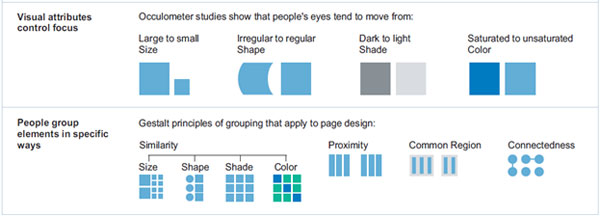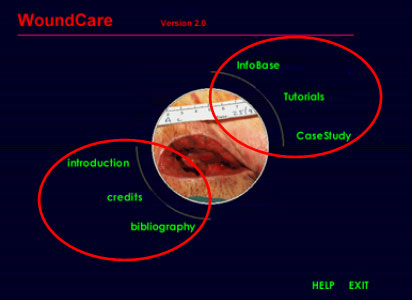- About us
- Contact us: +1.641.472.4480, hfi@humanfactors.com
Cool stuff and UX resources
Introduction
Do you ever find yourself at a loss for words?
Perhaps you said something like "could you bring me that thingamabob over there?"
If we don't know the right words, we fumble around talking about layouts with comments like "it's too loose" or "could you clean that up" or even "what were you trying to do?"
Many of our readers who have taken HFI's Science and Art of Effective Web and Application Design course have heard the principles of "gestalt" as applied to layout. As an HFI instructor I was very pleased and impressed when Phil Goddard updated this course in 2004 with a module on gestalt principles.
Recently, I found a 2002 paper that covered this topic in a systematic fashion.
The paper reminds us that indeed there IS a vocabulary for discussing layouts that are simple, compelling, and "naturally attractive".
Let's see how to talk about layout. Your professional vocabulary sets you apart and makes you a valuable expert on things no-one else knows.
First, we can say "naturally attractive" because Gestalt psychology was all about nature's design of the brain for visual perception.
Back in the 1930s perceptual psychologists asked the question, how does the untrained mind make visual sense of the jumble of colors, lines, and shapes that we see?
The Gestalt research showed that the mind seeks to see "wholeness" or the "Gestalt" (German: Gestalt â "essence or shape of an entity's complete form.")
From Wikipedia: "...the operational principle of Gestalt is that the brain is holistic, parallel, and analog, with self-organizing tendencies. The Gestalt effect is the form-generating capability of our senses, particularly with respect to the visual recognition of figures and whole forms instead of just a collection of simple lines and curves... The phrase 'The whole is greater than the sum of the parts' is often used when explaining Gestalt theory."
Our three authors, Chang, Dooley, and Tuvinen from Australia combed the Gestalt literature and found eleven Gestalt principles applicable to computer screen layouts. They applied the principles to a re-design of an educational application.
They had twelve participants rate the before/after layouts and got confirmation that the eleven Gestalt principles accomplished the job.
Let's see examples of each of their eleven laws of Gestalt from their instructional web site. Decide if you agree with their examples of the Laws of Gestalt.

Five laws of gestalt in the HFI module
The Quick Review summary handed out in the HFI design course shows five out of the eleven Gestalt laws presented by our three authors. Let's define them, below.
1. Law of Focal Point (Visual attributes that control focus)
The article points out that the focal point "catches the viewer's attention and persuades the viewer to follow the visual message further." For example, to capture your reader's attention, use one of the methods given in the HFI illustration above: "Visual attributes control focus".
Draw attention with something large, or irregular, or dark, or with a saturated color. Of course all of these "starter" shapes must stand out from the other elements on your page.
Our authors illustrated this law with a large scale graphic:
2. Law of Similarity
Both HFI and the authors cite the notion that "similar objects will be counted as the same group." In this example below, do you agree that viewers will feel all the circular controls are part of the same group? Instead of nine circles distracting attention, we see one group.
3. Law of Proximity
The authors state "items placed near each other appear to be a group." We see this in the HFI graphic above.
The illustration below shows circles around the elements that are grouped through the gestalt law of proximity. On the left, 14 menu items get perceived as "one" group. On the right, three pictures get perceived as "one" group, as well.
Such techniques simplify mental processing and fulfill the criterion of "processing fluency." See my December, 2009 UI Design Newsletter "User Experience" meets "Beauty is Truth, Truth is Beauty" for discussion of how gestalt principles support rapid assimilation of information.
4. Law of Common Region (Law of "Prägnanz ('Good Form')")
Simply put, "Good Form" arises from a collection of visual elements when the layout supports the feeling of "simplicity." HFI uses the phrase "Common Region" to describe one method of creating good form.
The German word for "good form" is "Prägnanz" â a word you might hear in graphic arts circles. When you want to impress your audience, and you won't embarrass yourself with faulty German pronunciation, see how it goes over. Be sure to define it, however.
In the illustration below, the brackets on both sides of the Lock button create a "good form" that triggers perception of the three circles as one unit. The mind simplifies the collection of three circles by perceiving the brackets as "enclosure". From there, we further process this as a single backward/forward "tool set".
5. Law of Connectedness ("Law of Unity/Harmony")
Another technique of grouping involves connecting the elements with some graphic element.The HFI illustration shows a line between items. The authors indicate that their Home Page associates the 6 menu links through the convention of two nearby curved lines.
In both cases, as the authors cite: "Unity implies that a congruity or arrangement exists among the elements in a design; they look as though they belong together, as though there is some visual connection beyond mere chance that has caused them to come together."












Six more laws of gestalt added by our authors
6. Law of Balance/Symmetry
What is the strongest "feel good" element of layout? Our authors indicated "A visual object will appear incomplete if the visual object is not balanced or symmetrical".
Even automated methods of assessing quality of web page designs include measures of symmetry, balance, and equilibrium. See my November, 2010 article "Visionary Usability: Making Friends With Graphic Design" for details.
Below, see how both the left/right axis and top/down axis manifest symmetry and balance. Does that symmetry make this home page feel or appear "complete"? I think so.
7. Law of Continuation
The other laws of Gestalt might be considered "static" in contrast to the Law of Continuation, which supports "the eye's instinctive action to follow a direction derived from the visual field."
This approach to simplification entails supporting the natural viewing pattern according to one's cultural background. European languages get read left to right, top down. Arabic and Hebrew are read right to left.
For textual content, we find that reading habits represent the instinctual "continuity" that ties together screen elements. However, the design must support that pattern of reading.
Thus, we have menus on the left that establish the start point of screen reading. Menus reveal the topic through the highlighted menu option. The page name at the top of the content section reinforces that topic as well.
Upon completing the reading task, the viewer scans the bottom elements to see what actions can be taken. Whatever the action is, the viewer resumes interaction by examining the menu on the left. This is all fairly automatic.
8. Law of Closure
Similar to the Law of Unity/Harmony, the Law of Closure deals with our desire for "completeness" in a visual experience. However, the Law of Closure brings emphasis to the fact that "our minds will tend to close gaps and complete unfinished forms."
The authors offer evidence in the form of their home page design. The circular motif of the center image plus the six menu options brings "closure" to the work of visual examination.
9. Law of Figure-Ground
What portion of your web layout is "figure" (foreground) and what is "ground" (background)? Choices of color, size, and embeddedness of visual elements all contribute to sense-making.
The Law of Figure-Ground captures the psychological fact that we need to determine what is important (figure) and what is secondary (ground).
Here, the figure (foreground) has lighter blue than the ground (background). This becomes a motif for the entire application. Light blue means "look here first".
10. Law of Isomorphic Correspondence
Our authors write "All images do not have the same meaning to us, because we interpret their meanings based on our experiences."
We see the truth of this statement in the case of the three buttons below. How do we understand this configuration? How do we know what they offer for interaction?
The answer comes from the Law of Isomorphic Correspondence. These buttons mimic the play-back controls for digital or analog devices. Or do they?
We might wonder what "Lock" does. Have we seen the word "Lock" on other devices? Perhaps not. But we have seen the playback icon as well as the record icon between two brackets.
That may be good enough to create an isomorphic correspondence with such devices.
11. Law of Simplicity
This law makes the observation that viewers make "an unconscious effort to simplify what is perceived into what the viewer can understand." In a sense, this appears to be a catch-all that subsumes the other ten laws of Gestalt already covered.
The Law of Simplicity addresses the question "But is it simple to use or view or understand?"
The authors suggest that observation of this law by the layout designer allows the viewer to reap the benefits.
As evidence of success, the authors offer these illustrations of their original instructional module. We leave it to you to determine if the Law of Simplicity triumphed in the redesign shown above.
Testing the whole gestalt
In a sense, any time you conduct a usability test, you get feedback on how well your design captures these Laws of Gestalt.
Can users find the right navigational options? Well, they are trying to obey the Law of Simplicity by looking where they expect navigation to appear.
Did you predict those expectations?
- You might have predicted where people look by following "best practices" emulated by other sites in your genre. (Law of Isomorphic Correspondence)
- Your design standards could maintain consistent places to look for navigation. The standard would have specified top level, second level, tertiary level, etc. navigation practices. (Law of Figure-Ground, Law of Continuation)
- Within these standards you could have supported user expectation with proximity of content elements â content gets grouped. (Laws of Proximity, Similarity, Closure)
- You could create focal points for navigation. HFI suggests that "dark areas" can support drawing attention to navigational areas at the top or left side of your layout. (Law of Focal Point)
Let us know how your updated, Gestalt-enriched vocabulary works for you.
And, remember, don't say Prägnanz unless you practice the pronunciation and get the Gestalt of it all.
In some cases "thingamabob" might be just the right thing to say.
References
Chang, D., Dooley, L. and Tuovinen, J.E. (2002). Gestalt Theory in Visual Screen Design - A New Look at an Old Subject. In Proceedings WCCE2001 Australian Topics: Selected Papers from the Seventh World Conference on Computers in Education, Copenhagen, Denmark. CRPIT, 8. McDougall, A., Murnane, J. and Chambers, D., Eds. ACS. 5-12.
Chang, Dempsey; Wilson, Cambell and Dooley, Laurence (2004). Towards Criteria for Visual Layout of Instructional Multimedia Interfaces. Journal of Educational Technology Systems, 32(1), pp. 3-29.
Message from the CEO, Dr. Eric Schaffer â The Pragmatic Ergonomist
Leave a comment here
Reader comments
Sam Ingersoll
q2Results
What do you think though about conversion design which suggests that many elements on websites like "privacy/security icons" and customer logos, etc...are important to include since they provide "in passing" visual clues that the owner, in this case, respects their privacy and is credible. I think many elements, but grouped correctly, is the answer. But I've seen plenty of cluttered sites including shopping carts that convert very well.
Sorin Stefan
Thank you for this article. Bookmarked...
I have a couple of questions:
1. You said occulometer studies shows that people's eyes move from dark shade to light shade and saturated to unsaturated colors. I think this happens when enough contrast is being provided in order for these "dark shades" and "saturated colors" to stand out. Without contrast it wouldn't be any "dark..." or "saturated..." What do you think?
2. Is Law of Common Region (Law of "Prägnanz ('Good Form')") like the Framing technique used in photography? It seems to me that way ... that said it feels like The rule of thirds has some subtle influence on the web also.
What do you think?
David Clark
Excellent! As someone with a deep background in Gestalt theory, therapy, and most recently, teaching Psychology to college students, I appreciate seeing these principles summarized and applied to Web design! Thanks!
T S S Ganesan,
Cognizant
Very nice article. Got to know more on the Gestalt principles. The examples were very helpful. Has driven me to know more of same.
Justin Calingasan,
Sulit.com.ph
Really minor comment here: the graphic you mentioned indicating the text "Lock" actually says "Back". But overall the Gestalt principle has got me hooked. Will read more on this and hopefully apply it in the workflow. It did actually reinforce certain concepts in my mind that have, up until now, have remained nameless.
James
Great article, I really enjoyed it. One point though: I'm sure it's a "back" button and not a "lock" button. What do you think?
Subscribe
Sign up to get our Newsletter delivered straight to your inbox
Privacy policy
Reviewed: 18 Mar 2014
This Privacy Policy governs the manner in which Human Factors International, Inc., an Iowa corporation (âHFIâ) collects, uses, maintains and discloses information collected from users (each, a âUserâ) of its humanfactors.com website and any derivative or affiliated websites on which this Privacy Policy is posted (collectively, the âWebsiteâ). HFI reserves the right, at its discretion, to change, modify, add or remove portions of this Privacy Policy at any time by posting such changes to this page. You understand that you have the affirmative obligation to check this Privacy Policy periodically for changes, and you hereby agree to periodically review this Privacy Policy for such changes. The continued use of the Website following the posting of changes to this Privacy Policy constitutes an acceptance of those changes.
Cookies
HFI may use âcookiesâ or âweb beaconsâ to track how Users use the Website. A cookie is a piece of software that a web server can store on Usersâ PCs and use to identify Users should they visit the Website again. Users may adjust their web browser software if they do not wish to accept cookies. To withdraw your consent after accepting a cookie, delete the cookie from your computer.
Privacy
HFI believes that every User should know how it utilizes the information collected from Users. The Website is not directed at children under 13 years of age, and HFI does not knowingly collect personally identifiable information from children under 13 years of age online. Please note that the Website may contain links to other websites. These linked sites may not be operated or controlled by HFI. HFI is not responsible for the privacy practices of these or any other websites, and you access these websites entirely at your own risk. HFI recommends that you review the privacy practices of any other websites that you choose to visit.
HFI is based, and this website is hosted, in the United States of America. If User is from the European Union or other regions of the world with laws governing data collection and use that may differ from U.S. law and User is registering an account on the Website, visiting the Website, purchasing products or services from HFI or the Website, or otherwise using the Website, please note that any personally identifiable information that User provides to HFI will be transferred to the United States. Any such personally identifiable information provided will be processed and stored in the United States by HFI or a service provider acting on its behalf. By providing your personally identifiable information, User hereby specifically and expressly consents to such transfer and processing and the uses and disclosures set forth herein.
In the course of its business, HFI may perform expert reviews, usability testing, and other consulting work where personal privacy is a concern. HFI believes in the importance of protecting personal information, and may use measures to provide this protection, including, but not limited to, using consent forms for participants or âdummyâ test data.
The Information HFI Collects
Users browsing the Website without registering an account or affirmatively providing personally identifiable information to HFI do so anonymously. Otherwise, HFI may collect personally identifiable information from Users in a variety of ways. Personally identifiable information may include, without limitation, (i)contact data (such as a Userâs name, mailing and e-mail addresses, and phone number); (ii)demographic data (such as a Userâs zip code, age and income); (iii) financial information collected to process purchases made from HFI via the Website or otherwise (such as credit card, debit card or other payment information); (iv) other information requested during the account registration process; and (v) other information requested by our service vendors in order to provide their services. If a User communicates with HFI by e-mail or otherwise, posts messages to any forums, completes online forms, surveys or entries or otherwise interacts with or uses the features on the Website, any information provided in such communications may be collected by HFI. HFI may also collect information about how Users use the Website, for example, by tracking the number of unique views received by the pages of the Website, or the domains and IP addresses from which Users originate. While not all of the information that HFI collects from Users is personally identifiable, it may be associated with personally identifiable information that Users provide HFI through the Website or otherwise. HFI may provide ways that the User can opt out of receiving certain information from HFI. If the User opts out of certain services, User information may still be collected for those services to which the User elects to subscribe. For those elected services, this Privacy Policy will apply.
How HFI Uses Information
HFI may use personally identifiable information collected through the Website for the specific purposes for which the information was collected, to process purchases and sales of products or services offered via the Website if any, to contact Users regarding products and services offered by HFI, its parent, subsidiary and other related companies in order to otherwise to enhance Usersâ experience with HFI. HFI may also use information collected through the Website for research regarding the effectiveness of the Website and the business planning, marketing, advertising and sales efforts of HFI. HFI does not sell any User information under any circumstances.
Disclosure of Information
HFI may disclose personally identifiable information collected from Users to its parent, subsidiary and other related companies to use the information for the purposes outlined above, as necessary to provide the services offered by HFI and to provide the Website itself, and for the specific purposes for which the information was collected. HFI may disclose personally identifiable information at the request of law enforcement or governmental agencies or in response to subpoenas, court orders or other legal process, to establish, protect or exercise HFIâs legal or other rights or to defend against a legal claim or as otherwise required or allowed by law. HFI may disclose personally identifiable information in order to protect the rights, property or safety of a User or any other person. HFI may disclose personally identifiable information to investigate or prevent a violation by User of any contractual or other relationship with HFI or the perpetration of any illegal or harmful activity. HFI may also disclose aggregate, anonymous data based on information collected from Users to investors and potential partners. Finally, HFI may disclose or transfer personally identifiable information collected from Users in connection with or in contemplation of a sale of its assets or business or a merger, consolidation or other reorganization of its business.
Personal Information as Provided by User
If a User includes such Userâs personally identifiable information as part of the User posting to the Website, such information may be made available to any parties using the Website. HFI does not edit or otherwise remove such information from User information before it is posted on the Website. If a User does not wish to have such Userâs personally identifiable information made available in this manner, such User must remove any such information before posting. HFI is not liable for any damages caused or incurred due to personally identifiable information made available in the foregoing manners. For example, a User posts on an HFI-administered forum would be considered Personal Information as provided by User and subject to the terms of this section.
Security of Information
Information about Users that is maintained on HFIâs systems or those of its service providers is protected using industry standard security measures. However, no security measures are perfect or impenetrable, and HFI cannot guarantee that the information submitted to, maintained on or transmitted from its systems will be completely secure. HFI is not responsible for the circumvention of any privacy settings or security measures relating to the Website by any Users or third parties.
Correcting, Updating, Accessing or Removing Personal Information
If a Userâs personally identifiable information changes, or if a User no longer desires to receive non-account specific information from HFI, HFI will endeavor to provide a way to correct, update and/or remove that Userâs previously-provided personal data. This can be done by emailing a request to HFI at hfi@humanfactors.com. Additionally, you may request access to the personally identifiable information as collected by HFI by sending a request to HFI as set forth above. Please note that in certain circumstances, HFI may not be able to completely remove a Userâs information from its systems. For example, HFI may retain a Userâs personal information for legitimate business purposes, if it may be necessary to prevent fraud or future abuse, for account recovery purposes, if required by law or as retained in HFIâs data backup systems or cached or archived pages. All retained personally identifiable information will continue to be subject to the terms of the Privacy Policy to which the User has previously agreed.
Contacting HFI
If you have any questions or comments about this Privacy Policy, you may contact HFI via any of the following methods:
Human Factors International, Inc.
PO Box 2020
1680 highway 1, STE 3600
Fairfield IA 52556
hfi@humanfactors.com
(800) 242-4480
Terms and Conditions for Public Training Courses
Reviewed: 18 Mar 2014
Cancellation of Course by HFI
HFI reserves the right to cancel any course up to 14 (fourteen) days prior to the first day of the course. Registrants will be promptly notified and will receive a full refund or be transferred to the equivalent class of their choice within a 12-month period. HFI is not responsible for travel expenses or any costs that may be incurred as a result of cancellations.
Cancellation of Course by Participants (All regions except India)
$100 processing fee if cancelling within two weeks of course start date.
Cancellation / Transfer by Participants (India)
4 Pack + Exam registration: Rs. 10,000 per participant processing fee (to be paid by the participant) if cancelling or transferring the course (4 Pack-CUA/CXA) registration before three weeks from the course start date. No refund or carry forward of the course fees if cancelling or transferring the course registration within three weeks before the course start date.
Cancellation / Transfer by Participants (Online Courses)
$100 processing fee if cancelling within two weeks of course start date. No cancellations or refunds less than two weeks prior to the first course start date.
Individual Modules: Rs. 3,000 per participant âper moduleâ processing fee (to be paid by the participant) if cancelling or transferring the course (any Individual HFI course) registration before three weeks from the course start date. No refund or carry forward of the course fees if cancelling or transferring the course registration within three weeks before the course start date.
Exam: Rs. 3,000 per participant processing fee (to be paid by the participant) if cancelling or transferring the pre agreed CUA/CXA exam date before three weeks from the examination date. No refund or carry forward of the exam fees if requesting/cancelling or transferring the CUA/CXA exam within three weeks before the examination date.
No Recording Permitted
There will be no audio or video recording allowed in class. Students who have any disability that might affect their performance in this class are encouraged to speak with the instructor at the beginning of the class.
Course Materials Copyright
The course and training materials and all other handouts provided by HFI during the course are published, copyrighted works proprietary and owned exclusively by HFI. The course participant does not acquire title nor ownership rights in any of these materials. Further the course participant agrees not to reproduce, modify, and/or convert to electronic format (i.e., softcopy) any of the materials received from or provided by HFI. The materials provided in the class are for the sole use of the class participant. HFI does not provide the materials in electronic format to the participants in public or onsite courses.


